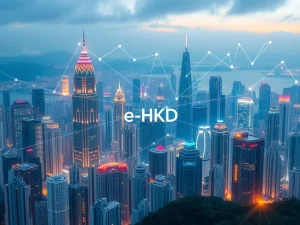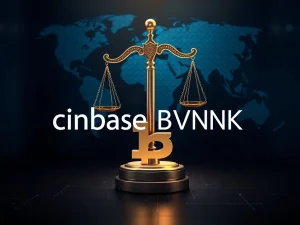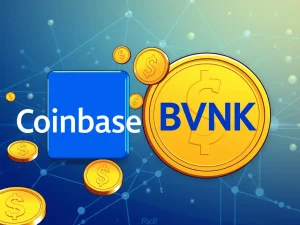Challenge to Tech Giants: Hoskinson’s Vision for Collaborative Tokenomics in 4th Gen Crypto

The cryptocurrency landscape is on the cusp of a seismic shift. As Web3 gains momentum and regulatory doors creak open for tech behemoths like Apple, Amazon, and Google, the very foundation of crypto’s competitive strategy is being questioned. Charles Hoskinson, the visionary behind Cardano, recently delivered a powerful message at Paris Blockchain Week 2025: the next generation of cryptocurrency, or 4th gen crypto, must embrace collaborative tokenomics to stand a chance against these incoming giants.
The Urgent Need for Collaborative Tokenomics in 4th Gen Crypto
Hoskinson didn’t mince words. He pointed out a critical flaw in the current crypto ecosystem: its often ‘circular economy’. In many instances, the rise of one cryptocurrency is fueled by funds flowing out of another. This zero-sum game, he argues, hinders the overall growth and sustainability of the industry. To truly flourish and compete with centralized tech giants, a paradigm shift towards collaborative tokenomics is not just beneficial, but essential.
Think about it. The current model often pits crypto projects against each other in a race for market share. While competition can drive innovation, in this context, it risks fragmentation and weakens the collective power of the decentralized movement. Hoskinson emphasizes that this adversarial approach is unsustainable when facing companies with trillions of dollars in resources and billions of users at their fingertips.
Why Tech Giants Pose a Formidable Challenge to Crypto
The impending entry of tech giants into the Web3 arena is not a hypothetical scenario. With clearer US regulations on the horizon, particularly around stablecoins, the barriers are falling. Imagine a world where Apple, Google, Microsoft, Amazon, and Facebook fully embrace cryptocurrency. Hoskinson paints a vivid picture:
- Massive User Base: These companies collectively command billions of users globally. Integrating crypto services into their existing platforms instantly grants them unparalleled reach.
- Established Infrastructure: They possess robust infrastructure, from payment systems to user interfaces, ready to be leveraged for Web3 applications.
- Financial Muscle: Their immense financial resources dwarf most crypto projects, enabling rapid development and aggressive market penetration.
Hoskinson specifically highlights Apple’s potential ‘wallet bundled with the iPhone’ as a game-changer. This underscores the sheer convenience and integration these tech giants can offer, posing a significant challenge to crypto projects striving for mainstream adoption.
Hoskinson’s Vision for Web3 Competition: Cooperation over Conflict
So, what’s the antidote to this looming Web3 competition? Hoskinson’s answer is clear: cooperation. He advocates for designing tokenomics and market structures that foster a ‘cooperative equilibrium’ rather than a ‘sum 0’ adversarial system. This means moving away from models where one project’s gain inherently means another’s loss. Instead, the focus should shift towards creating synergistic relationships where projects mutually benefit and contribute to the overall health of the crypto ecosystem.
He argues that 4th gen crypto needs to prioritize building infrastructure that not only serves individual projects but also becomes a valuable asset for the entire industry, including potentially even these incoming tech giants. This forward-thinking approach could transform the competitive landscape into a more collaborative and ultimately more powerful force.
US Regulation: A Catalyst for Tech Giant Entry and Crypto Evolution
The progress on US stablecoin legislation is a key factor influencing this impending shift. Hoskinson anticipates potential breakthroughs in the next couple of months, with a secondary bill – the GENIUS Act – further clarifying the regulatory landscape. These developments are crucial because:
- Regulatory Clarity: Clear rules of engagement reduce uncertainty and encourage larger institutions to enter the crypto space.
- Stablecoin Framework: Stablecoin legislation, like the GENIUS Act, addresses crucial aspects like collateralization and AML compliance, fostering trust and stability.
- Market Structure Bill: A market structure bill, potentially by September, could further streamline regulations, paving the way for broader adoption.
Hoskinson believes that once these regulatory barriers are removed, the influx of tech giants is not just likely, but almost inevitable. This regulatory tailwind could reshape the entire crypto market dynamics.
Cardano’s Minotaur: A Glimpse into Collaborative Crypto Future
Cardano is actively working on embodying this collaborative vision. ‘Minotaur,’ their multi-resource consensus protocol, exemplifies this approach. It aims to align incentives across multiple blockchain networks by:
- Combining Consensus Mechanisms: Integrating various consensus mechanisms for enhanced security and efficiency.
- Unified Block Reward: Distributing a single block reward across multiple participating networks.
- Multi-Network Security: Incentivizing multiple networks to contribute to the system’s security, fostering a shared responsibility.
- Flexible Payment: Allowing rewards to be paid in various currencies, increasing accessibility and adoption.
Minotaur showcases how collaborative tokenomics can be implemented in practice, creating a more interconnected and resilient blockchain ecosystem. It’s a concrete example of how 4th gen crypto can move beyond adversarial models and embrace cooperation as a strength.
Conclusion: A United Crypto Front Against Tech Titans
Charles Hoskinson’s message is a wake-up call for the cryptocurrency community. The era of isolated projects competing in a vacuum is fading. To effectively challenge tech giants entering Web3, a fundamental shift towards collaborative tokenomics is paramount. By fostering cooperation, building shared infrastructure, and aligning incentives, the crypto space can forge a united front, transforming the impending Web3 competition into an opportunity for collective growth and innovation. The future of 4th gen crypto hinges on its ability to embrace this collaborative spirit and build a truly decentralized and powerful alternative to the centralized tech dominance.







